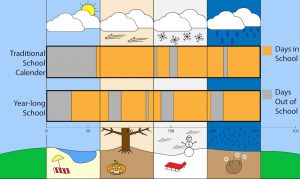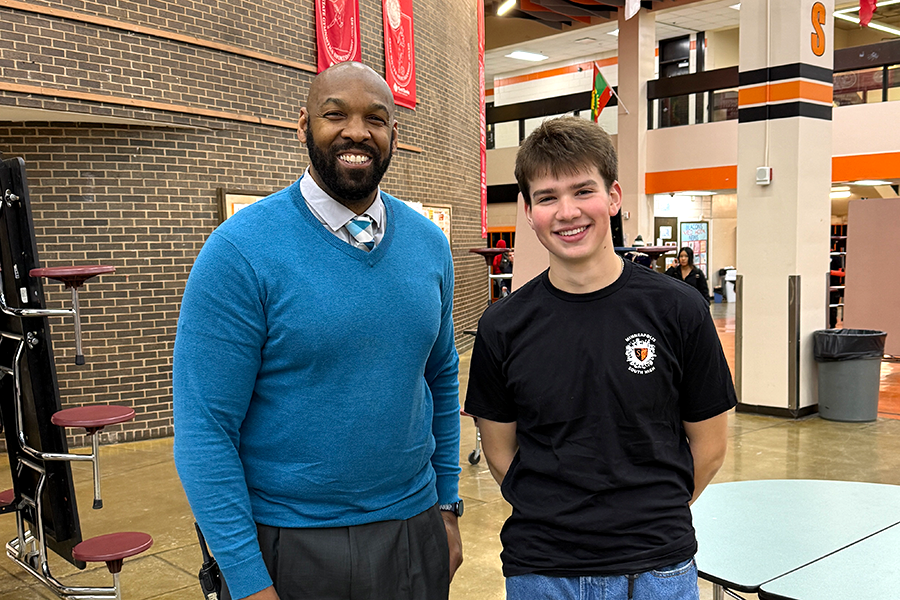In favor of year-round school
February 7, 2018
Winter break is nearing and many students at South are counting down the days. After a stressful semester, most high schoolers need these two weeks off to spend time with loved ones and relax, if not more. As one of the students who looks forward to this break, I believe that we need to provide students with more time off throughout the school year by transitioning to year-round school. This distribution of school days would be better for the mental health of students and teachers, and would improve the knowledge retention of all students and particularly benefit lower income students.
Although some countries that follow a year-round calendar have many more school days than the U.S., many American supporters of year-round school suggest the same number of school days simply with a different distribution.
South senior Lennon Baker thinks year-round school would be a better alternative to the system we have now. “I think that the current system that we that use is outdated and doesn’t suit the needs of modern students… A lot of people go home after the school year, and they come back and they’ve forgotten half of what they learned.”
Another proponent of year-long school at South is Michelle Ockman, an English teacher for the Open program. “I tend to get exhausted as a teacher. So, I really appreciate breaks and the possibility of four longer breaks… like a three week fall break, a three week winter break, a three week spring break and then a six week summer break. I think that would not only be awesome for teachers to be rejuvenated, but also for kids to have less time over the summer to lose what they’ve learned,” Ockman explained.
This learning loss – nicknamed the “summer slide” – describes the knowledge students lose over summer break. One study in Canada by The Globe and Mail newspaper found that students in year-round school did much better academically than their counterparts in a traditional school setting. The number of students who met or exceeded the province’s standards in year-round school was around twenty percent greater than the average.
This slide particularly affects lower income students. According to Lasting Consequences of the Summer Learning Gap from the American Sociological Review in 2007, two thirds of the ninth grade achievement gap in reading can be attributed to summer learning loss.
The truth is that only wealthier children are able to experience many of the opportunities those in favor of traditional schooling support. Enriching activities such as expensive summer camps and out of country vacations are not the reality for many students. So even if students from different socioeconomic backgrounds are leaving school with the same abilities, after three months it can be a different story.
Ockman also points out that school is a stable environment for many students: “For a lot of kids, school is a very stable place. So when they don’t have school, a lot of times they don’t get meals… or also make poor choices.” The stability seeing friends, supportive adults, and getting two meals a day, is a needed constant in the lives of many students.
Baker also thinks that year-round school could help the year to year transitions of high school. “There’d be less forgetfulness in terms of spending weeks or months away [from school]… It would be more of a slow progression. You wouldn’t see as many jumps, where people suddenly feel overwhelmed at the start of the year. I think it would be less stressful for a lot of students and help students adjust to harder classes as they age up,” Baker explained.
Another senior at South, Ted Jorstad, agrees. “I think that it would be better for students in terms of the material they are learning.” Jorstad added that year-long school would allow teachers to provide more depth to the content they are teaching.
Transitioning to year-long school may seem difficult, but its popularity in the U.S. is already increasing. A summary of year-round schools from the Congressional Research Service noted that from 1985 to 2000 the number of U.S. students in year round schools grew from 350,000 to 2,200,000. The process for our country to fully transition would be long and difficult, but it is possible.
Ockman outlined some of the details that might make year-long school successful. “I think when it starts in a community and it’s community-based and then it spreads that way, that’s probably easier for people to handle. If they feel like they’ve had some input or say on whether or not [year-long school] is going to happen, that’s helpful. Mostly just informing people about the benefits and how they’re lives are not going to fall apart… you have to communicate.”
I don’t believe that year-round school alone will solve all of our issues. To improve our education system we need better access to pre-kindergarten, more funding, and smaller class sizes. However, year-round school would be a good place to start.





